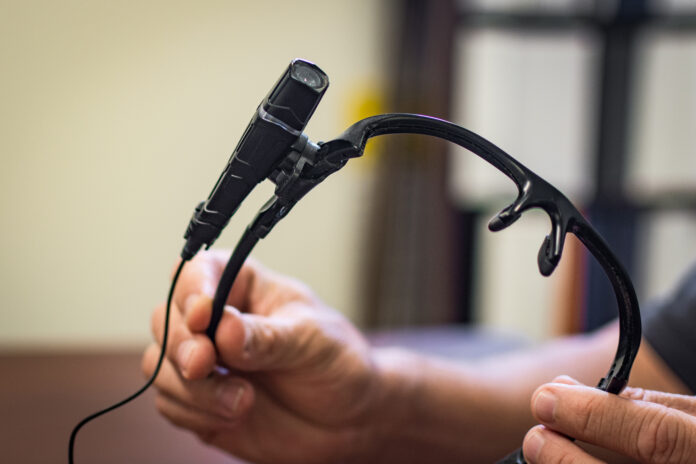
The Maricopa Police Department is looking to upgrade their 2-year-old, on-body camera program with updated technology in the hopes that the already successful program will become even more efficient.
Since 2015 MPD has had more than 40 body camera units in use. As a result, the department claims civilian complaints are down significantly.
MPD spokesman Ricardo Alvarado said from June 2015 to June 2016 the department received 20 citizen complaints. After equipping all on-duty officers with on-body camera units, from July 2016 to July 2017, MPD saw only six citizen-complaints directed at officers – a 70 percent decrease.
This decrease, Alvarado believes, is a result of citizenry being less likely to lodge frivolous complaints against officers, knowing they are on camera. Though he did acknowledge it could also be true that officers are less likely to abuse their power if they know they, too, are being watched.
“It’s not Big Brother watching you, but it is like somebody [saying], ‘Hey, would I normally do this,’” Alvarado said. “And, lieutenants and sergeants are required to go through and look at videos, not all the time, not every day, but randomly they’ll go through and say, ‘I want to see your video for the day.’”
Overall, Alvarado said, this success speaks volumes about the technology and its positive influence on civilian trust in law enforcement.
However, this isn’t to say the current system doesn’t have its shortcomings.
The units currently in service rely on the camera to be tethered to the officer with a short cord that can become detached with just a few pounds of pull. The cameras continue to record after they have become disconnected, though it slows the investigation process as the video must manually be taken from the camera.
To overcome this issue, within the next year or so, MPD hopes to acquire newer versions of the on-body cameras that stream video to cloud storage using Bluetooth technology. Alvarado said this wireless technology decreases the chances of disconnection while in the line of duty, thus enhancing the device’s productivity.
There are other issues that both the current units and prospective Bluetooth units possess, Alvarado said. An officer still has to start the camera themselves, and sometimes, in the heat of the moment, they can forget to do so.
“We’ve had incidents where when officers make traffic stops, by the time they get out of the car the violator is back at their car and it’s turned into a physical fight,” Alvarado said.
The battery for their current cameras give them a solid eight or nine hours of recording time, Alvarado said. Unfortunately, he said the issue is with data storage. The currently high-priced cloud storage technology makes continuous streaming cost-prohibitive.
At around $2,300 a piece, Alvarado said “the units themselves are reasonably priced; it’s the storage that’s expensive.”
Since the cameras record at 1080p, their average data consumption is around 24-26 gigabytes per hour, according to San Disk estimations. That means an average eight-hour shift, continuously recorded would need 192 gigabytes or more of data per officer. With eight officers per shift, and three shifts per day, they would need more than 4.5 terabytes of data per 24-hour period. At an industry average of about $0.01 per gigabyte, that is a potential $50 added to their storage bill each day, almost $1,500 added each month.
Until compression software becomes cheaper, or MPD can afford to host its own cloud servers, officers will likely continue to be required to press the record button.
One unique feature of their current units is a 30-second “buffer time.” The cameras record a short 30-second loop on internal memory. That loop allows officers to capture the 30 seconds prior to when they hit record. This means if an officer does press record immediately after they witness a crime or become engaged in an altercation, they will likely capture the incident on film.
Unfortunately, Alvarado said, the audio does not loop with the video, so it would only provide a portion of the story.
As technology improves, there is no doubt costs will become more manageable making continuous recording a likelihood in the near future.
In the meantime, the issue of body cameras becoming a standard piece of law enforcement equipment is not likely to exit the social dialogue.
As more and more reports surface of officer-involved shootings where body-camera perspective could have provided crucial details to the investigation, there is no doubt more and more departments will begin to assign their officers body cameras.





![Maricopa’s ‘TikTok Rizz Party,’ explained One of several flyers for a "TikTok rizz party" is taped to a door in the Maricopa Business Center along Honeycutt Road on April 23, 2024. [Monica D. Spencer]](https://www.inmaricopa.com/wp-content/uploads/2024/04/spencer-042324-tiktok-rizz-party-flyer-web-218x150.jpg)







![Alleged car thief released without charges Phoenix police stop a stolen vehicle on April 20, 2024. [Facebook]](https://www.inmaricopa.com/wp-content/uploads/2024/04/IMG_5040-218x150.jpg)



